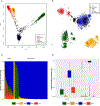Colorectal Tumors in Diverse Patient Populations Feature a Spectrum of Somatic Mutational Profiles
- PMID: 40126181
- PMCID: PMC12234169
- DOI: 10.1158/0008-5472.CAN-24-0747
Colorectal Tumors in Diverse Patient Populations Feature a Spectrum of Somatic Mutational Profiles
Abstract
Admixed populations, including the Hispanic/Latino/a community, are underrepresented in cancer genetic/genomic studies. Leveraging the Latino Colorectal Cancer Consortium (LC3) and other existing datasets, we analyzed whole-exome sequencing data on tumor/normal pairs from 718 individuals with colorectal cancer to map somatic mutational features by ethnicity and genetic similarity. Global proportions of African, Asian, European, and Native American genetic ancestries were estimated using ADMIXTURE. Associations between these proportions and somatic mutational features were examined using logistic regression. APC, TP53, and KRAS were the top three mutated genes across all participants and in the subset of Latino individuals in LC3. In analyses examining recurrently mutated genes, tumors from patients of Latino ethnicity had fewer KRAS and PIK3CA mutations compared with tumors from non-Latino patients. Genetic ancestry overall was associated with CDC27 mutation status, and African genetic ancestry was associated with SMAD2 mutation status. In exome-wide analyses, African genetic ancestry was significantly associated with higher odds of mutation in KNCN and TMEM184B. Native American genetic ancestry was associated with a lower frequency of microsatellite instability-high tumors. The SBS11 mutational signature was associated with Native American genetic ancestry as well as Latino ethnicity. In an independent replication dataset, MSK-IMPACT, estimates of association were largely consistent in direction but nonsignificant. A meta-analysis of LC3 and MSK-IMPACT showed that African genetic ancestry was significantly associated with KRAS mutation status and MSI status. This work facilitates precision medicine initiatives by providing insights into the contribution of genetic ancestry to molecular features of colorectal tumors. Significance: Analysis of tumors from various populations can broadly characterize genomic landscapes and enhance precision medicine strategies.
©2025 American Association for Cancer Research.
Conflict of interest statement
Figures


Update of
-
Spectrum of somatic mutational features of colorectal tumors in ancestrally diverse populations.medRxiv [Preprint]. 2024 Mar 15:2024.03.11.24303880. doi: 10.1101/2024.03.11.24303880. medRxiv. 2024. Update in: Cancer Res. 2025 May 15;85(10):1928-1944. doi: 10.1158/0008-5472.CAN-24-0747. PMID: 38558992 Free PMC article. Updated. Preprint.
References
-
- Ciardiello F, Ciardiello D, Martini G, Napolitano S, Tabernero J, Cervantes A Clinical management of metastatic colorectal cancer in the era of precision medicine. CA Cancer J Clin. 2022;72:372–401. - PubMed
-
- Islami F, Baeker Bispo J, Lee H, Wiese D, Yabroff KR, Bandi P, et al. American Cancer Society’s report on the status of cancer disparities in the United States, 2023. CA Cancer J Clin. 2023; - PubMed
MeSH terms
Substances
Grants and funding
- R01CA155101/National Cancer Institute (NCI)
- P20CA252733/National Cancer Institute (NCI)
- U2C CA252971/CA/NCI NIH HHS/United States
- U54 CA233465/CA/NCI NIH HHS/United States
- P30CA076292/National Cancer Institute (NCI)
- P50 CA285275/CA/NCI NIH HHS/United States
- P20 CA252733/CA/NCI NIH HHS/United States
- R01 CA155101/CA/NCI NIH HHS/United States
- P30 CA076292/CA/NCI NIH HHS/United States
- R01 CA248931/CA/NCI NIH HHS/United States
- R01CA284732/National Cancer Institute (NCI)
- U54CA163068/National Cancer Institute (NCI)
- P30CA014089/National Cancer Institute (NCI)
- U54CA233465/National Cancer Institute (NCI)
- U54 CA163071/CA/NCI NIH HHS/United States
- R01 CA284732/CA/NCI NIH HHS/United States
- U54CA163071/National Cancer Institute (NCI)
- Team Science Award/Moffitt Cancer Center (MCC)
- R01 CA238087/CA/NCI NIH HHS/United States
- U54 CA163068/CA/NCI NIH HHS/United States
- U2CCA252971/National Cancer Institute (NCI)
- P30 CA014089/CA/NCI NIH HHS/United States
- R01CA238087/National Cancer Institute (NCI)
- P50CA285275/National Cancer Institute (NCI)
- R01CA248931/National Cancer Institute (NCI)
LinkOut - more resources
Full Text Sources
Medical
Research Materials
Miscellaneous

